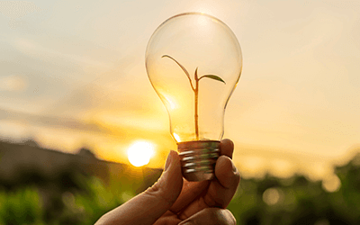How to get consumers to choose sustainable over conventional remains a puzzling question, but two sessions I attended at SB’18 Vancouver provided frameworks to help brands make some headway. One highlighted actionable ways practitioners can influence consumers to behave more sustainably with the SHIFT framework. In the other, Nice and Serious drew parallels to the story of David and Goliath to introduce the MAPS and MEE frameworks to help companies compete with conventional products.
Frameworks to SHIFT Behavior, Create MAPS for Product Marketing
How to get consumers to choose sustainable over conventional remains a puzzling question, but two sessions I attended at SB’18 Vancouver provided frameworks to help brands make some headway. One highlighted actionable ways practitioners can influence consumers to behave more sustainably with the SHIFT framework. In the other, Nice and Serious drew parallels to the story of David and Goliath to introduce the MAPS and MEE frameworks to help companies compete with conventional products.
The SHIFT Framework for Encouraging Sustainable Consumer Behaviors
Couldn't make it
to
SB'18 Vancouver****?
Check back here
for
more highlights
from the week!In her breakout session, Professor Katherine White of the University of British Columbia (UBC) shared five key concepts to consider regarding consumer behaviors and some of the research behind them.
SHIFT is an acronym outlining factors that communicators can leverage to influence behavior: Social influence; Habit formation; Individual self; Feelings and cognition; and Tangibility.
Social influence relates to social norms, desirability and group memberships. Essentially, you want to use normative language, increase social desirability, or make people want to either associate or dissociate with a certain group.
“People tend to look at the people around them; they want to do what others are doing and engage with others,” White explained. “Many things that are the norm are not sustainable. In North America, it’s very normative to drive a gas-powered car to work or to buy a cup of coffee in a disposable cup."
While these existing norms can perpetuate negative behaviors, normative language can be used to influence positive ones. For example, Nolan, Schultz et al (2008) found that normative messaging had the greatest effect on homeowners’ energy consumption behavior compared to informational, environmental, social responsibility and self-benefit (cost saving) messaging.
Social desirability is more about branding and how you market a product, such as how Tesla makes electric vehicles seem cool. Brands can also associate their products with aspirational figures, as Colgate has done with its water-saving campaign with Michael Phelps.
Another approach is to highlight public contexts. For example, White referred to a study where people were given choices between products where one option highlights its environmental benefits and the other option highlighted personal benefits. One group of respondents was told that their choices would be known by others, while the other group was told their choices would not be shared. Perhaps unsurprisingly, the group who thought their answers would be public were more likely to choose the environmentally friendly option that the group who thought their answers would be private.
As for the ‘group membership’ piece, communicators can appeal to who people want to be or who they want to avoid being associated with. The former approach is straight-forward enough, and has been proven with initiatives such as Don’t Mess with Texas, which campaigns against littering by appealing to Texan pride and working with celebrities such as Matthew McConaughey and Willie Nelson.
Leveraging dissociative groups can be a bit more delicate, but can still be effective if well-executed, especially if framed as a competition. For example, students at the University of Calgary were more likely to compost coffee cups when they were told a rival student group was composting more than their group was, than they were when told about their group’s performance alone. Similarly, Earth Hour has encouraged competitions between cities to fuel positive behavior change.
Habit formation relates to both breaking bad habits and forming positive ones.
Penalties for bad behavior – such as bag fees, littering fines, or even a carbon tax – have to be carefully tracked to determine their level of effectiveness. Leveraging discontinuity is often an easier approach to breaking bad habits. The idea is to take advantage of breaks in routine since they are prime opportunities to change behavior. White explains that psychologists call this the “fresh start mindset,” adding its “similar to starting a diet on New Year’s or after your birthday.”
The keys to forming positive habits are making it easy, giving feedback, offering incentives, and using prompts. White used Nest smart thermostats as an example of the first two. Nest uses preset temperatures that save energy – making it easy through the use of default settings – and gives users feedback on the individual level as well as compared to other Nest users. Recyclebank offers users incentives to recycle. Prompts are simply reminders, such as “no idling” signs in school pickup areas. White notes that prompts “work best when consumers see it when they can change the behavior.”
Individual self relates to a person’s values, their concept of themselves and making commitments.
Examples of values-driven communications include Patagonia’s “Don’t Buy This Jacket” campaign and its public criticisms about President Trump stripping forest land protection; Method’s appeals to families with a focus on health and safety; and Nike’s appeals to innovation and performance. You can also appeal to self-values by breaking down barriers, as Tesla did by introducing high performance EV options at an average new car price point.
Individuals’ concepts of themselves can sometimes be a bigger barrier than you might think. As White explained, “Generally people want to view themselves positively. One reason men are sometimes less likely to choose the sustainable option is because they view it as feminine and may feel uncomfortable or threatened by that.” It’s a rationale that has prompted campaigns that appeal to masculinity and challenge preconceptions around plant-based diets.
You can also capitalize on commitments and how they drive consistency. People are more likely to continue with the positive action if they've committed to it. The more public and durable the commitment, the better. However, you also must be wary of “slacktivism” and encourage people to do more than simply “Like” your Facebook page by getting involved or donating to a cause. Otherwise they may feel like they have already “contributed” and be less motivated to do something next time.
Efficacy also plays a role; it is helpful when people believe they can engage in the desired action (ability efficacy) and have confidence that their actions will have an impact (outcome efficacy).
Feelings and cognition is perhaps the most familiar of these elements. Appeal to people’s emotions – whether negative or positive – the heart rather than the head. However, White cautions that negative messages should be moderated. Greenpeace has been criticized for messages or images that are so negative or shocking that people are less inclined to respond. Others such as Canada’s David Suzuki Foundation stress the importance of taking action by promoting what can be done, appealing to emotions on both sides.
Tangibility is important because for most people sustainability is an abstract notion. “Making impacts tangible is more likely to motivate people to change their behavior,” White said.
Ways to do this include verifying sustainable attributes, making comparisons or using analogies, and making impacts clear and local. Certifications are good, but it is often more important to bring the message to life. For example, Tide used an image of an Empire State Building made of Tide containers with the message “If everyone in New York City were to wash their laundry in cold water for ONE DAY this would be enough electricity to light up the Empire State Building for one month,” and a Toyota ad highlighted that the Prius produces less emissions than a sheep.
“Making [your message] more clear, local and relevant makes it more tangible,” White added. An effective example is environmental messages on gas pumps with local endangered species at risk due to climate change.
Now that you’re familiar with the five aspects of SHIFT, how can you actually use it to influence consumers to care more about sustainability issues and behave more sustainably? White concluded with a 6-step process:
- Clarify the context. Think about the context, your goals and the behavior.
- Select your target segment. Identify your target market.
- Determine the details. Determine the specific needs, barriers and benefits.
- Select and apply the tools. Take SHIFT tools that reflect your context, target, barriers and benefits.
- Test your strategy. Pilot your strategy; you may need to return to a previous step.
- Implement your plan and evaluate outcomes.
The Proof Is in the Pudding: How to Get People to Choose Sustainable Over Conventional
Nice and Serious co-founder Ben Meaker and creative strategist Christopher Fiorello provided further insights on influencing consumers in their breakout session. While we know that consumers value the environment and social good, it can still be difficult to shift their behavior or convince them to spend a bit more money on a product that is in line with those values. Through their social-impact creative agency, Meaker, Fiorello and their team help brands with more sustainable or ethical products take on conventional product “Goliaths.”
The speakers highlighted five recommendations for effective marketing of sustainable products, drawing parallels to the story of David and Goliath along the way and sharing their lived experience creating a marketing campaign for an imaginary marshmallow product.
Recommendation #1: Selling “sustainability” is just plain selling. Even David needed a weapon for his battle with Goliath, and traditional sales and marketing techniques are still effective. As such, Nice and Serious says it is key to use these tools at your disposal rather than selling on sustainability alone or as a “sustainability person.”
Recommendation #2: Find your MAPS. MAPS is an acronym for Market, Audience, Product and Scene. These are the same basic components you would usually consider for a marketing campaign; where is your market, and who are the market leaders and your competitors? Who is your target audience? What are the selling points of your product? How does your product or brand fit amidst the current social landscape? (For example, with plastic pollution becoming a more prominent issue in the public eye, this aspect of the “scene” means more people are asking questions about plastic products and packaging and seeking sustainable options.)
MEE is another acronym, but is more specific to shaping your campaign. It stands for Motivation, Ease and Emotion. As Fiorello put it, “Which of these 3 are you going to use to sell your sustainable product and switch consumers from a more conventional option?”
They used an analogy of a bow, arrow and target for MEE. Motivation was compared to the string in the bow that creates tension to push for behavior change. Some of the most effective motivations are:
- Utility – the features, bells and whistles. E.g. Tesla emphasizes vehicle performance.
- Reciprocity – how people feel more compelled to give or do something if you give or do something first. E.g. Giving free samples.
- Ownership – E.g. When Coca-Cola printed people’s names on its bottle labels.
- Play – associating what people buy with having a good time. E.g. Corona’s use of beaches in its marketing.
- Reframing – E.g. When HEINEKEN entered the light beer market, it ditched the stereotype of ‘cheap beer for bros,’ branded their product as ‘premium light beer’ to reframe it as a beverage and brought Neil Patrick Harris on board to add to a sophisticated image.
- Scarcity – leveraging people’s fear of missing out by implying scarce supply. E.g. Offers only available for a “limited time.”
Ease is the element that sharpens the arrow to make it easier for it to fly true, land the sale and hit your target. Mainly, this means your audience needs the how-to and access they need to purchase and use your product or service.
Emotion is represented by the target because it is the most challenging but effective part. As Fiorello said, “If you can create an emotional connection between a customer and your brand, you’re winning.”
He covered two ways to do this: Evocation – dialling up the emotions, such as with Always’ #LikeAGirl campaign; and Modelling – using spokespeople that customers find aspirational. While major celebrities are losing favor and trust among the public, there has been a rise in the power of “micro-influencers,” especially on social media with younger audiences.
Finally, Meaker introduced the marshmallows. As a fun exercise in building a brand from the ground up, he and his team came up with the idea to imagine they were launching a new marshmallow product. Fun fact: marshmallow root used to form the basis of marshmallows and actually has some medicinal properties. But much has changed since their origins in Egyptian times – the French started making marshmallow treats with gelatin, and later air extrusion made them fluffy. Long story short, marshmallows as we know them do not contain any marshmallow root and two brands hold 95 percent of the billion-dollar (root-less) marshmallow market. This explanation leads us to the next insight: Every Goliath has a weak spot.
Recommendation #3: If you know why consumers are loyal to the market leader, you know how to change their behavior. Meaker stressed the importance of understanding who is in your market space and why customers are loyal to those companies.
To use the marshmallow example, there may be an opportunity to appeal to parents looking for healthier alternatives with simpler ingredients. They considered their MAPS: existing products in the market are not particularly sustainable and have lengthy ingredient lists; parents are purchasing these treats for their children; Nice and Serious’ marshmallows could use marshmallow root, all vegan ingredients and organic ingredients where possible; and people are reading more labels, spending less time outside, and there’s a war on sugar.
They dubbed their imaginary product Roots & Hoots and decided on four focuses for their branding: quality, fun, natural and “hip” – because it would have to be fresh enough to draw people away from the well-established brands they’ve long been loyal to. “We wanted to find three or four levers that would activate consumers to choose our product,” Meaker explained.
They also looked to other brands in similar situations. For example, Annie’s broke into the mac n’ cheese market, but after five years of growth, still only has about 10 percent of the billion-dollar market compared to Kraft’s roughly 90 percent. Which brings us to the next insight: the bigger they are, the harder they fall.
Recommendation #4: Be patient, it takes a lot of stones to topple a giant.
Nice and Serious tested their new brand with focus groups. They tested three different text and image-based ads for Roots & Hoots: two focused on motivation (utility in the form of better ingredients and reframing what marshmallows actually are or should be) and one evoking emotion (in that parents want to make better choices for their kids). The focus on utility was most successful, so they used that for their next test.
They made a brand that was as generic and fitting with eco stereotypes as possible and found that nearly 85 percent of people stuck to the Goliaths, Kraft Jet-Puffed and Campfire. Then, they tested the Roots & Hoots brand and found consumer preference for the eco-option increase by 76 percent. Roughly 50 percent chose Jet-Puffed, 20 percent chose Campfire, and Roots & Hoots moved to second place as the choice of 30 percent. However, those choices were made under the assumption that all of the products were being offered at the same price. With prices attached, Campfire, the cheapest of the three, rose to 50.5 percent, Jet-Puffed fell to 41 percent, and Roots & Hoots dropped to a mere 8.5 percent. The results bring us to Nice and Serious’ final recommendation from the session.
Recommendation #5: Find ways to be nimble, especially on price. Just as David turned down armour so he could stay nimble during his battle with Goliath, so must your brand try to stay nimble as it grows. As with any product, optimizing on price will deliver the greatest benefits, since price remains the main influencer of purchasing decisions – at least for now.








